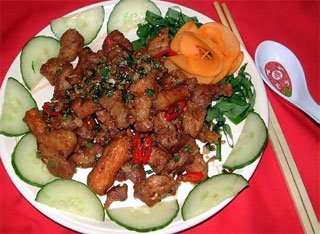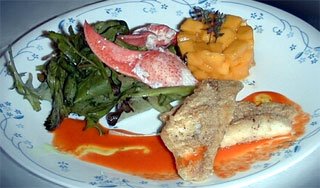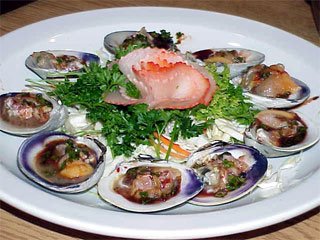Chinese Cuisine, Features, Local Styles, Medicated Diets
Chinese culinary arts are famous all over the world. Chinese dishes appeal to the senses through color, shape, aroma and taste. Chinese cuisine's entree normally strives for three to five colors, made up of the main ingredient, with more secondary ingredients of contrasting colors and textures; these are prepared and cooked to enhance their own qualities, with the use of appropriate condiments and garnishing, enabling to chef to present a delicious platter of fragrant delicious art.
In prepared dishes, the stronger fragrant aroma stimulates one's appetite, by using scallion, fresh ginger, root garlic or chili pepper; with the use of wine, aniseed, cinnamon, peppercorn or sesame oil. Complementary nuances are added. Soy sauce, sugar, vinegar and other seasonings may used discreetly, adding to the complex play on the taste buds.
All chefs of the Chinese kitchens, professional or in the home, strive for harmony of sight, smell, taste, texture, so that each individual dish has it's unique features highlighted; contrasted and balanced if it is a dinner of many dishes, be it 3, 6, 9 or 12. The flavors must not overpower, yet subtle enough to meet the tastes of those dining. Complex or simple dishes may be prepared quickly or much longer, but the ultimate goal is to share with the guests the play on the eaters' real and imagined visions of the dishes and its ingredients.
Once the meal is cooked, it is served all at once to the family, who eat with chopsticks and drink soup with a wide spoon. The average dinner includes a starch -- rice, noodles, bread, or pancakes -- a meat dish, vegetable, and soup, which serves as a beverage. For formal meals and banquets, there are many successive courses which are served in a strict traditional order. A further point is that over festive periods, with the play of word's phonetics, well meaning felicitous names of dishes have many people trying to guess what they are about to eat, thereby adding fun to eating.
Chinese food enjoys a high reputation in the world also for its sheer abundance. It is due to the diversity of the climate, products and customs that there are widely different food styles and tastes in local regions.
For local styles, Beijing cuisine combines the best features of different regional styles. Shangdong cuisine leads the Northern dishes. Shangdong cooks are good at cooking seafood. Sichuan cooks specialize in chilies and hot peppers and Sichuan dish is famous for aromatic and spicy sauces. Guangdong cooking makes use of many ingredients. They look for fresh, tender, crisp textures. Huai Yang cuisine stresses the natural flavors. Dishes are strong but not greasy, and light but delicate. Tan cuisine is both sweet and salty. There is a saying that "southerners have a sweet tooth, and northerners crave salt", but Tan dishes manage to satisfy both. Because China's local dishes have their own typical characteristics, Chinese food can be divided into eight regional cuisines, the distinction of which is now widely accepted.
Shandong Cuisine
Consisting of Jinan cuisine and Jiaodong cuisine, Shandong cuisine, clean, pure and not greasy, is characterized by its emphasis on aroma, freshness, crispness and tenderness. Shallots and garlic are frequently used as seasonings so Shandong dishes taste pungent. Soups are given much emphasis in Shandong cuisine. Thin soups are clear and fresh while creamy soups are thick and taste strong. Jinan chefs are adept at deep-frying, grilling, pan-frying and stir-frying while Jiaodong chefs are famous for cooking seafood with a fresh and light taste.
Typical menu items: Bird's Nest Soup; Yellow River Carp i n Sweet and Sour sauce
n Sweet and Sour sauce
Sichuan Cuisine
Sichuan Cuisine, known more commonly in the West as Szechuan Cuisine, is one of the most famous Chinese cuisines in the world. Characterized by its spicy and pungent flavors, Sichuan cuisine, with a myriad of tastes, emphasizes the use of chili. Pepper and prickly ash are always in accompaniment, producing the typical exciting tastes. Garlic, ginger and fermented soybean are also used in the cooking process. Wild vegetables and meats such as are often chosen as ingredients, while frying, frying without oil, pickling and braising are used as basic cooking techniques.
It can be said that one who doesn't experience Sichuan food has never reached China.Typical menu items: Hot Pot; Smoked Duck; Kung Pao Chicken; Twice Cooked Pork; Mapo Dofu
 Guangdong Cuisine (Cantonese Cuisine)
Guangdong Cuisine (Cantonese Cuisine)
Tasting clean, light, crisp and fresh, Guangdong cuisine, familiar to Westerners, usually has fowl and other meats that produce its unique dishes. The basic cooking techniques include roasting, stir-frying, sauteing, deep-frying, braising, stewing and steaming. Steaming and stir-frying are most frequently used to preserve the ingredients' natural flavors. Guangdong chefs also pay much attention to the artistic presentation of their dishes.
Typical menu items: Shark Fin Soup; Steamed Sea Bass; Roasted Piglet
Fujian Cuisine
Combining Fuzhou Cuisine, Quanzhou Cuisine and Xiamen Cuisine, Fujian Cuisine is renowned for its choice seafood, beautiful color and magical tastes of sweet, sour, salt and savory. The most distinct feature is their "pickled taste".
Typical menu items: Buddha Jumping Over the Wall; Snow Chicken; Prawn with Dragon's Body and Phoenix's tail
Jiangsu Cuisine

Jiangsu Cuisine, also called Huaiyang Cuisine, is popular in the lower reaches of the Yangtze River. Using fish and crustaceans as the main ingredients, it stresses their freshness. Its carving techniques are delicate, of which the melon carving technique is especially well known. Cooking techniques consist of stewing, braising, roasting, and simmering. The flavor of Huaiyang Cuisine is light, fresh and sweet and its presentation is delicately elegant.
Typical menu items: Stewed Crab with Clear Soup, Long-boiled and Dry-shredded Meat, Duck Triplet, Crystal Meat, Squirrel with Mandarin Fish, and Liangxi Crisp Eel
Zhejiang Cuisine
Comprising local cuisines of Hanzhou, Ningbo, and Shaoxing, Zhejiang Cuisine is not greasy. It wins its reputation for freshness, tenderness, softness, and smoothness of its dishes with their mellow fragrance. Hangzhou Cuisine is the most famous one of the three.
Typical menu items: Sour West Lake Fish, Longjing Shelled Shrimp, Beggar's Chicken
Hunan Cuisine
Hunan cuisine consists of local cuisines of Xiangjiang Region, Dongting Lake and Xiangxi coteau areas. It is characterized by thick and pungent flavors. Chili, pepper and shallot are usually necessities in this variation.
Typical menu items: Dongan Chicken; Peppery and Hot Chicken
Anhui Cuisine
Anhui Cuisine chefs focus much more attention on the temperature in cooking and are good at braising and stewing. Often ham will be added to improve taste and candied sugar added to gain freshness.
Typical menu items: Stewed Snapper; Huangshan Braised Pigeon
Chinese medicinal cuisine is unique in China and has a long history. Sun Simiao, a leading Tang Dynasty doctor, once said, "Food has the function of eliminating evil influences and soothing the vital organs, cultivating one's mind and building up one's strength." In China, people contend that food tonic is much better than medicine tonic in fortifying one's health. Based on traditional Chinese herbal medicine practice, it combines strictly processed traditional Chinese medicine with traditional culinary materials to produce delicious food with health restoring qualities. To cook medicinal food, one has a large variety of fine materials to choose from and each material has its own unique flavor. Generally, processed herbal materials are more commonly used in order to avoid strong odors. However, individuals of different physical status need to select different herbs. The selection of herbs will depend on each individual's condition of health. Due to its herbal nature, it is better to take medicinal food according to the doctor's prescription.
materials to produce delicious food with health restoring qualities. To cook medicinal food, one has a large variety of fine materials to choose from and each material has its own unique flavor. Generally, processed herbal materials are more commonly used in order to avoid strong odors. However, individuals of different physical status need to select different herbs. The selection of herbs will depend on each individual's condition of health. Due to its herbal nature, it is better to take medicinal food according to the doctor's prescription.
In the cooking of medicinal food, slow cooking methods such as stewing, braising and simmering are usually used in order to extract more of the herbs' healing properties.
Typical medicine cuisine:
Baby Pigeon Stewed with Gouqi (Medlar) and Huangqi (Membranous Milk Vetch);Pork Simmered with Lotus Seed and lily;
Pig's Kidney Stewed with Eucommia Bark.
Online Shop?














No comments:
Post a Comment